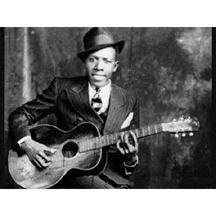Robert Johnson (May 8, 1911 – August 16, 1938) was an American blues singer-songwriter and musician. His landmark recordings in 1936 and 1937 display a combination of singing, guitar skills, and songwriting talent that has influenced later generations of musicians. Johnson’s shadowy and poorly documented life and death at age 27 have given rise to much legend, including the Faustian myth that he sold his soul to the devil at a crossroads to achieve success. It was only after the reissue of his recordings in 1961, on the LP King of the Delta Blues Singers, that his work reached a wider audience. Johnson is now recognized as a master of the blues, particularly of the Mississippi Delta blues style. He is credited by many rock musicians as an important influence; Eric Clapton has called Johnson “the most important blues singer that ever lived”. Johnson was inducted into the Rock and Roll Hall of Fame as an early influence in its first induction ceremony, in 1986. In 2010, David Fricke ranked Johnson fifth in Rolling Stone magazine’s “100 Greatest Guitarists of All Time”. (More from Wikipedia)
“Rollin’ Stone” by Muddy Waters is a bridge from the raw blues of Robert Johnson directly to rock and roll; while it is basically a straight blues song, there are startling changes in the beat and cadences over the course of “Rollin’ Stone”. Within the blues world, it is a direct antecedent to Muddy Waters’ 1954 recording of the Willie Dixon song “I’m Your Hoochie Coochie Man” (Steppenwolf included “Hoochie Coochie Man” on their 1968 debut album Steppenwolf, among numerous other covers by various rock musicians), Bo Diddley’s “I’m a Man” (1955), and Waters’ answer “Mannish Boy” (also in 1955). I suppose that Bo and Muddy had a pretty good rivalry going back then, but on several occasions, I saw a performance of “I’m a Man” by Muddy Waters in later life on a series of films on TV called Living Legends of the Blues – that rendition even leaves the cover of “I’m a Man” by the Yardbirds in the dust.
To some extent at least, the formation of Cream grew out of an English all-star band called the Powerhouse that was assembled solely to provide music for a 1966 compilation album called What’s Shakin’ that announced the arrival of Elektra Records in Great Britain. Bandmembers included Eric Clapton (guitar); Jack Bruce (bass guitar) and Paul Jones (harmonica) from Manfred Mann; Stevie Winwood (lead vocals) and Pete York (drums) from the Spencer Davis Group; and Ben Palmer (piano), who had briefly been in a band with Clapton in 1965. Ginger Baker was originally slated to be the drummer for the group but was unavailable. This remarkable line-up included two members of Cream (and almost all three), plus two future members of Blind Faith (Clapton and Winwood). What’s more, Cream later recorded two of the only three songs ever made by this assemblage, Robert Johnson’s “Crossroads” and an instrumental called “Steppin’ Out” that Eric Clapton had previously performed while in John Mayall & the Bluesmakers. The artist on these two songs was listed as Eric Clapton & the Powerhouse. The third song, “I Want to Know” was credited to MacLeod, an evident reference to Paul Jones’ wife Sheila MacLeod; Ten Years After included “I Want to Know” on their first album, Ten Years After that was released in late 1967.
(May 2014)
* * *
“The Stranger” is preceded by a fine cover of a Robert Johnson song (always a good sign) called “Me and the Devil Blues”. It is played and sung pretty much like the rest of the songs – no need for Phil Gammage’s band to disturb their groove even for a classic blues cover. But each song has its own personality.
(March 2015)















